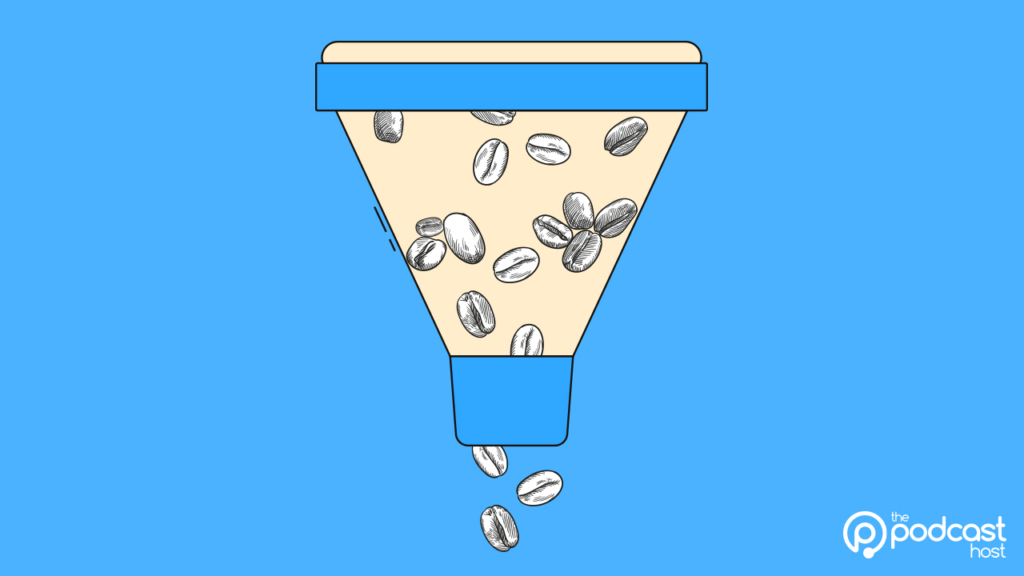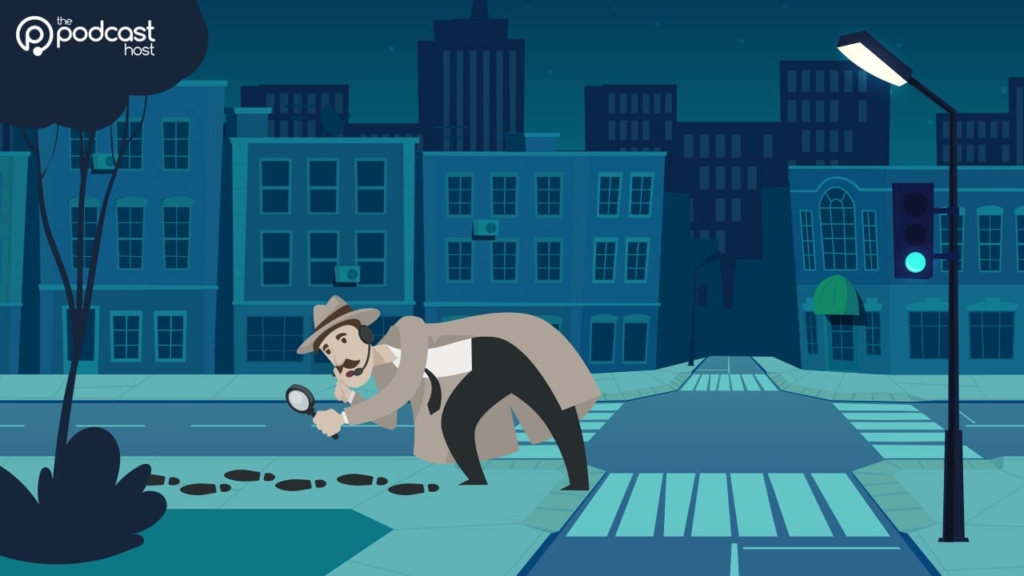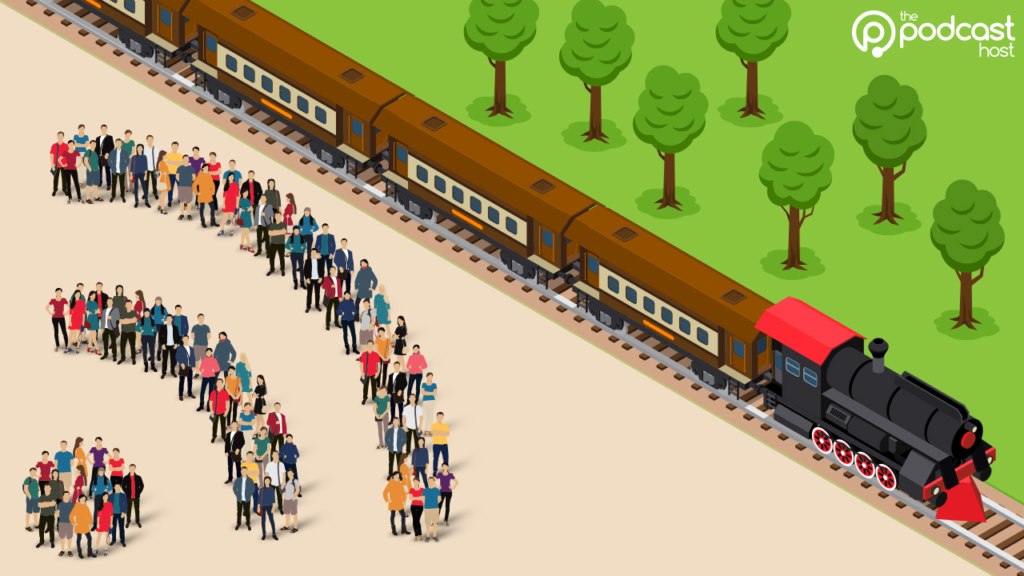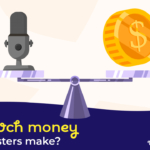How to Set Up a Podcast Sales Funnel
Unless you’re a Luddite time traveller from the distant past, if you’re reading this, you’ve bought something online in the past year. Or, maybe you’ve sold something online. If you’ve used the Internet at all in the past five years, especially social media, you have definitely been sold to. My point is, you have been involved in a sales funnel, whether or not you were aware of it. All businesses have them. Whether your podcast is business-related, or not, you can benefit from learning how to set up a podcast sales funnel.
And, if you are a Luddite time traveller from the distant past, I have a lot of questions for you, but that’s another topic.
What Is a Podcast Sales Funnel?
It’s the process by which you convince people to get them to do something, such as:
- buy a product you’re selling (an e-book, a webinar, a tangible object)
- tell other people about your podcast and spread the word (this can be a reasonable end goal for podcasters when they’re first starting out)
- change a habit (like, stop overeating or using plastic grocery bags, start doing yoga daily)
- join your church, country club, or charitable organization
- attend a live show
It’s called a funnel because at the outset, you’re going to make your ideas available to the widest possible group of interested parties. Over time, the people who are the best match for your product continue moving through decision stages. Eventually, the most committed people come through and buy in. After that, their support should continue to sustain your work.
Picture a funnel. Now, imagine pouring coffee beans into it. Coffee beans are basically all the same size and shape, but not exactly. The most irrregular beans will stick to each other. The beans best suited to the shape of the funnel will slide down and through the channel at the bottom.

How does a Sales Funnel Work?
A sales funnel is a series of stages where people make choices based on information. They are:
- Awareness or Information, where you throw your information out to the widest number of people, so someone’s heard of you
- Gathering Information, where the audience gets to learn more about you and your products or services
- Evaluation or Comparison, where they can compare your products and services to find what’s unique
- Decision or Negotiation
- Purchase
- Re-Evaluation
- Re-Purchase and/or Upsell
How does this apply to podcasts, though?
What Do I Need for a Podcast Sales Funnel?
First, ask yourself: Is your podcast a promotional tool for a product, or is it the product itself? When I first started podcasting, my podcast was the product. My first podcast was an audio drama. I wanted people to listen. When the end goal is to make a podcast and to grow your audience, a sales funnel can help you make income to make your podcast sustainable.
But, sometimes the podcast is a PR tool to convince people to buy something else. Some brands use their podcast to influence public opinion about their company and products. Some businesses use their podcast as an audio newsletter, to share information about their business directly and notify their customers of any upcoming changes, sales or promotions.
Either way, you need to have a clear goal in mind, so you know if the horse is pulling the cart, or the cart is pulling the horse.
You need:
- a reliable means of communication with your audience that you control. This is your podcast itself, your social media, a website, and an email list.
- A stable place for people to find more information about you and your podcast. This is a website, and it should include a media kit.
- A way for your audience to communicate with you (again, email and/or social media)
- A commerce platform. This is how your audience can give you what you want in exchange for what they need.
I’ll walk you through the resources a podcaster needs at each stage of the sales funnel. The following example is fictional, but you can adapt it for most business situations.
An Extremely Simple Example of a Podcast Sales Funnel
Jenna has been knitting handmade items for over 30 years. She makes hand-knit socks that she sells at her town’s local farmer’s market on Saturdays. Her hand-knit socks are extremely beautiful and comfortable, but they cost more than a pair of machine-knit socks from a big-box store. It’s hard for Jenna to sell enough socks to continue renting a spot at the farmers’ market. Jenna decides to make a podcast to promote her sock knitting business.
Part 1: Awareness
Jenna makes a podcast about knitting. She talks about how she knits socks, techniques, yarn, yarn suppliers, sheep, needles, patterns, and she interviews local yarn store owners. This is the Awareness part of Jenna’s sales funnel. People who search for podcasts about knitting and crafts can find her podcast on all major platforms. She uses clear calls to action in her podcast intros and outros, to get people to come visit her table at the farmers’ market.
Part 2: Gathering Information
Podcasts about knitting are great. But, knitting is a tactile, visual medium, too. Though she talks about texture, weight, and color, her episode show notes can include links to her podcast web site, so people can see her stitch pattern and color choices for themselves. This can include information about the farmers’ market where she sells the socks, so people know when and how to get there. In this stage, potential customers simply want more information. The information needs to be available on the customers’ terms. Clear show notes, a web site, and social media accounts help them consume the information on their own.

Part 3: Evaluation or Comparison
This doesn’t have to be negative. Jenna can use her podcast to compare machine-knit socks to hand-knit socks, analyzing durability, comfort, etc. Jenna can share the spotlight with other knitters outside of her target market. This stage of the podcast sales funnel shows the potential customers the benefit of buying her socks, over other socks. Building a community helps people share ideas about product benefits.
Part 4: Decision or Negotiation
Does this part happen in your podcast? Generally, this would happen at the point of sale, but there are ways to address it elsewhere, too. A reliable email marketing list, with consistent messages, can accelerate the negotiation process. People who have signed up for the mailing list are already familiar with the podcast, web site, products, or all of these. With an email list, subscribers are already trading something (their contact information and consent to receive email) for access to your podcast and ideas. So, Jenna can use her email marketing to clarify the sales negotiation. For example, subscribers to the email list may get a discount. She can also create a sense of urgency, i.e., “I’m only going to have baby alpaca yarn from Peru for three more pairs of socks, and they’re going on sale this Saturday.” She can also use this stage of the podcast sales funnel to ask the audience what kind of socks they like to wear, or what kind of hand-knit items they value.
Part 5: Purchase
Here’s the goal of Jenna’s podcast sales funnel: new customers come to the farmers’ market and buy her socks. That’s the end, right? Not really. This is where the relationship is made concrete, exchanging money for socks. If Jenna’s podcast sales funnel is truly successful, her customers are satisfied. Not only will they continue to buy Jenna’s socks in the future, they will get other people to buy her socks, too. So, how can Jenna ensure this?
Good customer service, obviously, is a must. The point of sale is a good time to slip a business card in with their socks and make sure the line of communication is open.
In the purchase stage, Jenna needs an ecommerce platform. In Jenna’s case, she can sell her socks for cash at the farmer’s market. But, what about podcast listeners who live in another country, or can’t physically get to the farmers’ market? Jenna could use an online marketplace like Etsy or Uncommon Goods, which would take care of the online admin in exchange for a fee. But, her online and in-person sales would be completely separate. So, she’d have to have separate inventory for each point of sale.
if Jenna wants more control, she could set up her own online store. Convertkit combines email marketing and ecommerce, so it’s easier to engage, sell to, and follow up with customers. Here at Podcast Host, we like them so much, we have an affiliate program with them. Check them out: even their free tier is particularly robust.
Whichever she chooses, the ecommerce platform needs to have a way for her to keep the lines of communication with her customers open. You’ll see why in the next stage.
Part 6: Re-Evaluation
This stage of the podcast sales funnel is going to happen whether Jenna wants it to, or not. As customers wear her socks, they may have buyer’s remorse. Maybe the socks shrink in the wash. Maybe the novelty wears off, so they stop listening to the podcast, or reading her email marketing. Or, maybe they become more enthusiastic, and want to tell all their friends about her. How can Jenna make sure the re-evaluation stage goes in her favor?
Jenna needs to make it easy for her customers to get in touch if they’re dissatisfied, and make it right. She needs to show them that she appreciates their business. Some ways she can do that are:
- Ask if she can share a photo with them and their new socks on social media.
- Ask for their name, and if she can mention them in the next podcast recording.
- Give a small discount or a free gift (such as a simple knitting pattern) to people who mention the podcast when they buy the socks.
- Make sure they have her contact information in case they have any questions about the socks.
- Send a follow-up email to thank them for their purchase and offer to ask any questions.
Again, a business card (better yet, with a QR code to her website) goes a long way to help satisfied customers stay satisfied.
Part 7: Re-Purchase and/or Upsell
Here’s where the sales funnel gets really narrow. On the one hand, someone who buys your products is already committed. What you want now is for them to be repeat customers. You want them to enthusiastically recommend your products, or at the very least, tell them about your podcast. What are some ways that Jenna can reward repeat business, or doing her PR for her?
- Start a “secret sock club,” with a private podcast feed that has exclusive content for members who pay a subscription fee
- Invite committed customers to be part of a live podcast episode
- Use a tool like SpeakPipe on the website to let enthusiastic customers leave messages, which she can include in the podcast
You can think of plenty of ways to involve your customers. The more that you make people feel included, and reward their participation, the more they will promote your business and content.

Podcast Sales Funnels
By this point, you can substitute “socks” for whatever it is you want to sell, and have plenty of good ideas about how to set up a podcast sales funnel that best fits your needs. Essentially, put yourself in your customer’s shoes (sorry. I’ll stop with the footwear metaphor). You want to lead your customer to buy your product, while making them feel smarter for doing so. if you already have a business, a podcast is a great way to inform, educate, and entertain your customers. If you already have a podcast, a sales funnel can help you financially sustain your project over the long haul.
Whew, that was a lot of information, wasn’t it? Fortunately, not all of our resources are as long, or metaphorical. We can help you on your podcasting journey, at any stage. Podcraft Academy has courses, downloadable resources, and more, that you can consume and digest at your own pace. Plus, our Weekly Live Q&A sessions are great discussions of any and all podcasting questions you might have. Not only that, but also, our all-in-one podcasting tool, Alitu, can help you record, edit, polish and publish your podcasts, so you can focus on making great content, and connecting with your audience. Try it for free!

